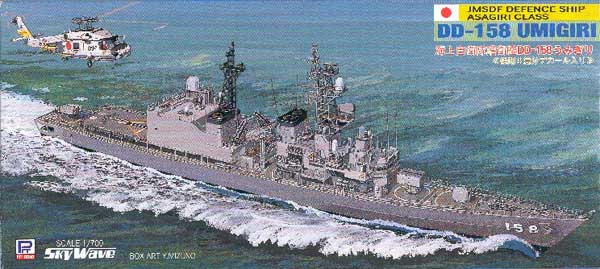| The eight ships of the Asagiri Class
Multi Purpose Destroyers joined the Japan Maritime Self-Defense Force (JMSDF)
from 1988 to 1991. The class is powered by 4 Kawasaki-Rolls-Royce
Spey SM-1A gas turbines, generating 53,900 shaft horsepower to two controllable
pitch propellers. The class is well suited for anti-submarine work
with, ASROC, Type 68 ASW torpedoes, a SH-60J ASW helicopter, towed tactical
passive sonar array and Mitsubishi OQS-4A bow mounted medium frequency
sonar (an improved version of the US SQS-23). In addition, they carry
8 RGM-84C Harpoon SSM, a Mk 29 Sea Sparrow missile launcher (18 missiles
can be carried), 2 20 mm Mk 15 Phalanx CIWS, one 76-mm 62 cal. OTO Breda
Compact gun, Mk 36 SRBOC decoy systems and the U.S. SLQ-25 Nixie acoustic
torpedo system. All this on a length of 449 ft, max beam of 48 feet,
4,300 tons full load, quite a punch for a vessel this size. |
|
|
| Either in plastic or resin, Skywave and its resin sister
companies (Hi-Mold and WaveLine) have released just about all the current
vessels of the JMSDF. I have always liked the look, style and the powerful
punch the JMSDF ships. The Skywave kit J14, DD-158 Umigiri, depicts the
last ship of the Asagiri class. |
| This kit is not a new release but has been around for some time. The
kit is highly detailed, the molding is extremely crisp with very little
flash evident. The detail on the superstructure matches well with
published pictures. The hull of the kit I have has no sink marks
and can only be built as waterline, standard Skywave practice. Also
in standard practice in 1/700, the helicopter deck and the main deck have
raised lines to depict painted lines and walkways. The hull depicts
the sheer line well and specs out extremely well with published dimensions. |
Click images
to enlarge
 |
|
|
| The masts are over-scaled but not as thick as older kits and, in my
opinion, look okay as is. |
 |
|
| The back of the box is loaded with information about the ship's
dimensions, weapons, sensors, complement, painting guide and decal location.
The painting guide uses Pit-Road Ship Colors, Gunze Sangyo Mr. Color paints
plus FS numbers when applicable. The painting guide is easy to follow
except in one area. On the bow of the ship the guide says to paint
the walkway (distinguished on the model with raised lines) with USS Gray
(2) (USN modern deck gray) but the color shown on the guide is the same
as the rest of the deck, which is to be painted PC-2 (JMSDF Gray (2)).
Amidships the walkways are shown with a different color but again the stern
is all shown the same color. Luckily the front of the box has a wonderful
paining by Y. Mizuno which clearly shows the walkways a shade darker than
the rest of the deck. The back of the box also contains painting instructions
for the SH-60J helicopter, no confusion with this illustration. |

|
|
|
| The decals provide hull numbers to build anyone of the last 5 ships
of the Asagiri Class. Decals are provided for the SH-60J helicopter
as well as the helicopter landing markings. If you want the decals
to lie flat then the raised lines must be sanded down. While usually
this is not an overly difficult task, on JMSDF ships Skywave also depicts
the helicopter tracks with raised lines but provides no decals for these
if you sand them off. On previous JMSDF kits I have chosen not to
sand the lines off and the decals on top of the raised lines do not look
that bad. Warning circle decals are provided for the OTO Melara 76mm
gun, the ASROC and the Sea-Sparrow launcher. Hull numbers, ship names,
helicopter landing pad numbers are also provided. There are plenty
of decals for the SH-60J helicopter. All decals are crisp and well
defined. |
 |
| The only disappointment in the kit I can find is that it
does not come with a modern weapons sprue. I love the all the extra
parts that come with these sprues and I guess I expect this in all Skywave
kits. Overall this is an excellent kit with a great deal of detail
and would make a nice out of the box build. |

